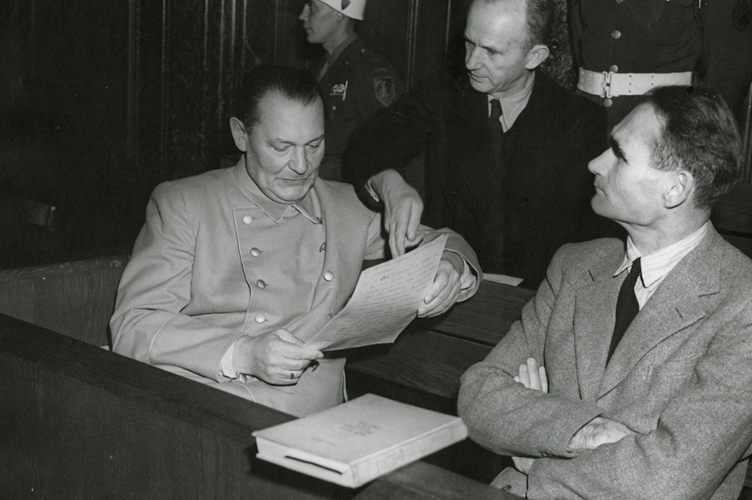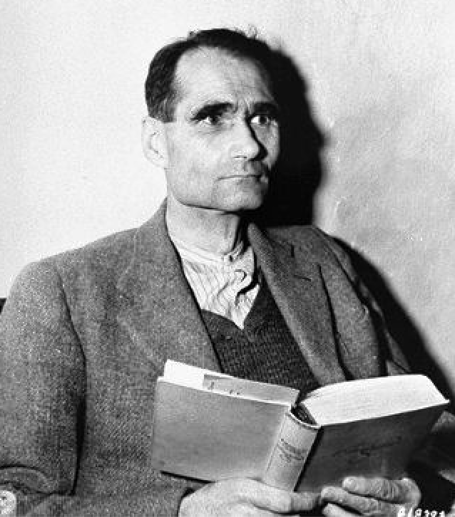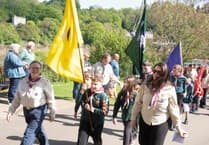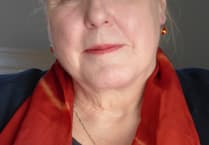IF you happened to pay a visit to the lazy lawns and elegant decay of White Castle near Llantilio Crossenny between 1942 and 1945, you might have seen a tall and aloof looking gentleman with a slightly distant look in his eyes, painting and sketching the swans which used to frequent the moat.
As in the way some people do, his general demeanor and slightly superior swagger would suggest that here is someone who considers himself a cut above, a man marked out from the common breed either by personal distinction or high office.
That impression would deepen significantly when taking into account the nonchalant but nevertheless watchful pair of men in close proximity to the painter of swans.
For they were high-ranking military personal and the man at the easel was their prisoner. By night he was kept under lock and key at Maindiff Court and by day he was allowed to roam the more picturesque areas surrounding Abergavenny pretty much at will.
The curious-looking fella with the intense eyes, peculiar gait, foreign tongue, and brooding brows was well known amongst many of the townspeople - they called him the Abergavenny Kaiser. His real name was Rudolf Hess and he was once the Deputy Führer of Nazi Germany.
How did such a historic figure end up under lock and key in a sleepy market town in Wales?
More importantly, was it the real Hess people often saw taking in the sights at White Castle and various other spots? Or was it a carefully staged doppelgänger and decoy?
We may be entering the outlandish realms of conspiracy theory but for years there has been much speculation and debate as to exactly why Hess ended up in Maindiff Court Hospital, and if the man imprisoned there was Hess at all.
Before we look at all the ins and outs in this particular saga let’s rewind the tape for a brief history lesson.
On May 10, 1941, Old Blighty had a strange and unexpected guest who parachuted into a field near Eaglesham in Scotland. At first, the strange man who fell from the skies insisted to the authorities his name was Alfred Horn. It later transpired the pilot who flew solo almost 1,000 miles from Bavaria in a Messerschmitt Bf110 was none other than Rudolph Hess.
Before his capture, it’s difficult to underestimate what a key player Hess was in the Third Reich. He was responsible for typing up Mein Kamp whilst being held in Bavaria’s Landsberg Prison alongside Hitler after the failed 1924 Munich Putsch. Hess was so besotted with Nazism he once wrote, “Adolf Hitler is simply pure reason incarnate.”

Upon his initial capture, Hess gave a false name and insisted on meeting fellow aviator, The Duke of Hamilton, because he had an important message for him. Hess mistakenly believed that the Duke was part of a pro-Germany and anti-government faction which could help broker a peace between the two countries.
Hess’s wish was denied and he was taken into custody. He remained adamant that Hitler knew nothing of his solo mission and the Führer’s architect, Albert Speer, reported that Hitler flew into a blind rage upon hearing the news of Hess’s capture.
The anti-Nazi Konrad Heiden wrote a few months after Hess’s flight, “With Rudolf Hess, Adolf Hitler’s better half disappeared from Germany. The two had become intellectually conjoined to a degree that is possible only in abnormal personalities.”
On June 26, 1942, Hess was transferred from Mytchett Place to Maindiff Court as Abergavenny was recommended as a quiet place where the leading Nazi could have more freedom.
Here’s where the water gets muddy. Former Army surgeon Hugh Thomas who examined Hess in Spandau prison in September 1973 believes the man pretending to be Hess was an impostor. Why? Because he said he couldn’t find any scars on his body from wounds inflicted in Romania during the First World War.
Following the white rabbit even deeper down the hole, Thomas speculated that the real Hess was murdered, but was it before or after he arrived at Maindiff?
The rumors about a decoy taking the place of the real Hess at Maindiff Court began to circulate when he arrived at the hospital in an army estate car, accompanied by two officers, but no military escort.
Additionally, there was hardly a lack of secrecy in Abergavenny that Hess was coming to town. Officialdom didn’t appear remotely bothered that such a key player was arriving in such a relatively unguarded area. What’s more, he was allowed considerable freedom to pretty much roam the local area on a whim. Hardly the freedoms which are usually given to most high-ranking and high profile POWS at danger of being rescued by the Germans or kidnapped by the Poles.
The Chronicle didn’t officially mention Hess’s stay in the town until he was transferred to Nuremberg. However, on September 1, 1943, the Daily Mail carried a story with the headline, “The Daily Life Of Hess In Prison Camp.” which detailed Hess’s location and routine. Something which could not have happened under wartime censorship without the government’s tacit approval at some level.
As outlandish as it seems the Daily Mail article would appear to suggest that the government of the time wanted the public both British and German to know that Hess was being kept at Maindiff Court.
Another factor that poured even more fuel on the fire was that within days of his capture, the government expressly forbid anyone to take pictures of Hess. This ruling was even enforced during the lax regime of the Maindiff Court days.
From 1941 to 1945, Hess’s stay in the UK remains completely undocumented in a photographic sense.
The parliamentary secretary to the Minister of Information Harold Nicholson explained this was because, “Such ignominy should not be put on this fundamentally decent man.”
Another curious contrast between the Hess of Mychett Place and the one of Maindiff is that before arriving in Abergavenny Hess was teetotal and a vegetarian, afterwards he began eating meat and drinking alcohol.
And then there was the Hess of Nuremberg who failed to recognize other Nazis, gave the wrong date of birth (1899 instead of 1894) and refused to see his beloved wife and son until 1965.
Hugh Thomas would fan the flames further when he claimed he had a letter he was prevented from publishing due to the Official Secrets Act. Apparently, the letter was from Lord Willingdon to the Canadian Prime Minister William Mackenzie which discussed Hess and referred to “the problem we had with the double.”
It’s a tough theory to swallow and its biggest flaw is the nagging question of why an alleged double welcome life imprisonment with open arms instead of revealing their true identity.
Who would willingly volunteer to be imprisoned, grow old, and die in such unpleasant conditions on behalf of someone else?

The late Joe Clifford was one of Hess’ guards at Maindiff, and the Abergavenny man never once thought Hess wasn’t the real deal.
Mr. Clifford told the Abergavenny Chronicle in 2009, “I remember one of my first impressions of Hess was how tall he was, the arrogant manner in which he held himself, and how he usually walked with a semi-goosestep, throwing his feet out. He seemed to think that we were more his servants than his guards.
“At night I would be posted outside his bedroom and sometimes Hess would come out of his bedroom and walk into the garden. I would walk behind him, but he would never talk to me. He was a rather haughty and aloof man and I think he felt the likes of me were beneath him.
“Even though he could speak English, he very rarely spoke, except to the officers who he sometimes dined with. He never talked to any of the guards.
“I never saw Hess behave strangely. I never observed him speaking to himself, or staring strangely.
“I do know that in February 1945 he made a suicide attempt by stabbing himself twice with a bread knife, but he only scratched himself with it.”
Mr Clifford added, “Most days Hess would sit on the verandah reading, writing and drawing. He would normally wear a blue sports coat, grey flannel trousers, and sandals in the summer, and in the winter a long blue overcoat. Now and again he would dress up in his uniform - the uniform he flew over in from Germany.”
And of course, that uniform was Rudolph Hess’s real uniform because the man at Maindiff has since been proven to be, beyond all reasonable doubt, the Deputy Führer.
In 2019 DNA analysis was taken from a long-lost blood sample of Hess. It was compared with a known surviving relative and it was almost a conclusive match. There is a one percent chance that the man at Maindiff and Spandau was not Hess, but we’ll take those odds.
One of the most enduring conspiracy theories surrounding the Second World War has been finally laid to rest, and as a bonus, Abergavenny gets to keep its Kaiser.
More recently, another engaging theory seeks to prove that Hess was placed in Abergavenny because he had a family connection to Wales.
Historian Phil Carradice told BBC News in 2022 that Hess was sent to Abergavenny because it’s possible his father Carl, “actually lived in Cardiff for a short while.”
Carradice explained, “Certainly Carl’s first wife was buried in the the parish churchyard at Michaelston-y-Fedw (on the city’s outskirts).”
The historian also believes that Hess’s possible relationship with Lord Tredegar might also have been a factor in the Nazi’s arrival in Abergavenny.
“Lord Tredegar was something of an eccentric peer who was in charge of messenger pigeons during the war, just the sort of man who Hess thought he should be dealing with,” explained Carradice, who added, “Hess was wowed by everything aristocratic and the idea that he could talk to them on the same level flattered his sensitive ego.”





Comments
This article has no comments yet. Be the first to leave a comment.